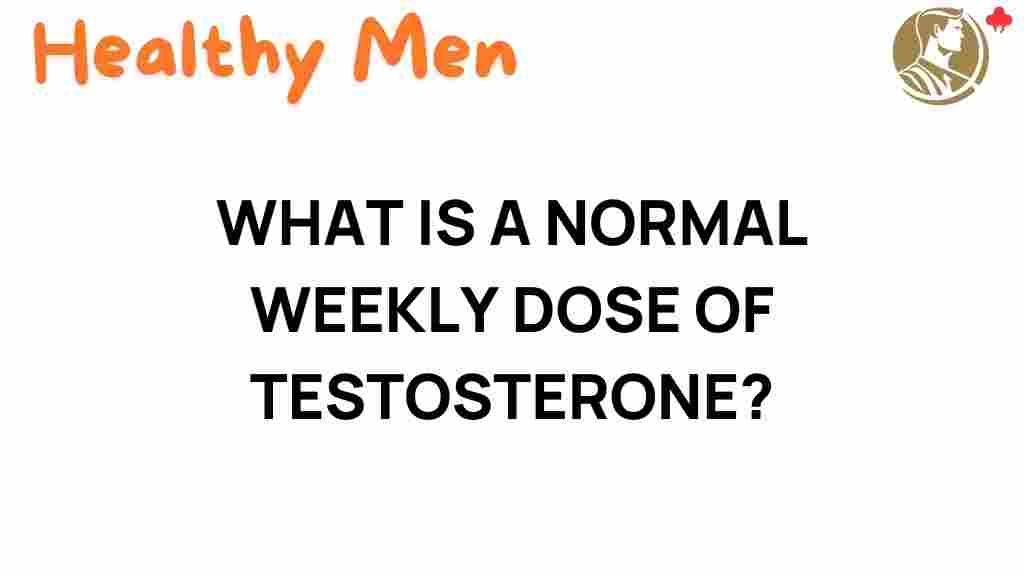Unveiling the Secrets: What is a Normal Weekly Dose of Testosterone?
Testosterone is a vital hormone that plays a crucial role in men’s health, influencing everything from physical fitness to emotional wellness. Understanding the normal weekly dose of testosterone can help individuals achieve a balance that promotes optimal health and performance. In this article, we will explore testosterone levels, the appropriate dosages, and factors affecting hormone balance.
Understanding Testosterone and Its Importance
Testosterone is primarily produced in the testicles in men and in smaller amounts in women’s ovaries and adrenal glands. It is essential for various bodily functions, including:
- Regulating libido
- Maintaining muscle and bone mass
- Supporting mood and cognitive function
- Contributing to the production of red blood cells
Normal testosterone levels contribute significantly to overall wellness and fitness. When testosterone levels are imbalanced, it can lead to various health issues, including fatigue, depression, and decreased muscle mass.
Normal Testosterone Levels
The typical range for testosterone levels can vary widely. According to the Mayo Clinic, normal testosterone levels in adult males generally range from:
- 300 to 1,000 ng/dL (nanograms per deciliter)
It is important to note that these levels can fluctuate based on a variety of factors, including age, time of day, and individual health conditions. For instance, testosterone levels are usually highest in the morning and gradually decline throughout the day.
What is a Normal Weekly Dose of Testosterone?
The normal weekly dose of testosterone varies based on the method of administration and individual health needs. Common methods include injections, patches, gels, and pellets. Below is a breakdown of standard dosages for different administration methods:
1. Testosterone Injections
Testosterone injections are one of the most common methods of delivery. The typical dosage ranges from:
- 50 mg to 400 mg per week
Physicians usually start patients on a lower dose and gradually increase it, monitoring hormone levels and symptoms along the way.
2. Testosterone Gels
For testosterone gels, the typical weekly dose is about:
- 50 mg to 100 mg applied daily
Gels provide a more stable release of testosterone and allow for easier self-administration.
3. Testosterone Pellets
Testosterone pellets are implanted under the skin and release testosterone over time. The usual dose is:
- 200 mg to 600 mg every 3 to 6 months
This method provides long-term hormone delivery and is convenient for many patients.
4. Testosterone Patches
Testosterone patches typically deliver about:
- 2 mg to 8 mg per day
These patches are applied to the skin and provide a steady absorption of testosterone.
Factors Influencing Testosterone Dosage
Several factors can influence the appropriate dosage of testosterone for an individual:
- Age: Testosterone levels naturally decline with age, leading to potential adjustments in dosage.
- Body Composition: Individuals with higher body fat percentages may require different dosages.
- Health Conditions: Conditions like obesity and diabetes can affect testosterone levels.
- Medications: Certain medications may impact hormone levels and require dosage adjustments.
Monitoring Testosterone Levels
It is essential to regularly monitor testosterone levels to ensure they remain within the normal range. This monitoring typically includes:
- Blood tests to measure testosterone levels.
- Evaluation of symptoms related to low or high testosterone.
- Assessment of potential side effects from testosterone therapy.
Regular follow-ups with a healthcare provider specializing in endocrinology can help maintain hormonal balance and overall health.
Troubleshooting Common Issues
While testosterone therapy can be beneficial, some individuals may experience issues. Here are common troubleshooting tips:
1. Low Energy Despite Therapy
If you feel fatigued even after starting testosterone therapy, consider:
- Reviewing your dosage with your healthcare provider.
- Exploring other underlying health issues, such as thyroid problems.
- Evaluating lifestyle factors such as diet and exercise.
2. Mood Swings or Irritability
Hormonal fluctuations can lead to mood changes. Address this by:
- Discussing any mood changes with your healthcare provider.
- Incorporating stress-reduction techniques like meditation or yoga.
- Ensuring you have a balanced diet rich in nutrients.
3. Weight Gain
Some individuals may notice weight gain during treatment. To manage this, consider:
- Increasing physical activity, focusing on strength training and cardiovascular health.
- Consulting with a nutritionist for personalized dietary advice.
- Monitoring caloric intake to maintain a healthy balance.
Conclusion: Achieving Balance for Optimal Health
Understanding the normal weekly dose of testosterone is crucial for maintaining hormone levels that support men’s health, wellness, and fitness. By working closely with healthcare professionals and monitoring individual responses to therapy, men can achieve a hormonal balance that enhances their quality of life.
For more information on testosterone therapy and hormone balance, you can visit Mayo Clinic. If you’re considering testosterone therapy, consult with an endocrinologist to tailor the approach to your unique health needs.
Remember, achieving optimal health is a journey, and understanding your body’s needs is the first step towards wellness.
This article is in the category Lifestyle and created by healthymen Team
